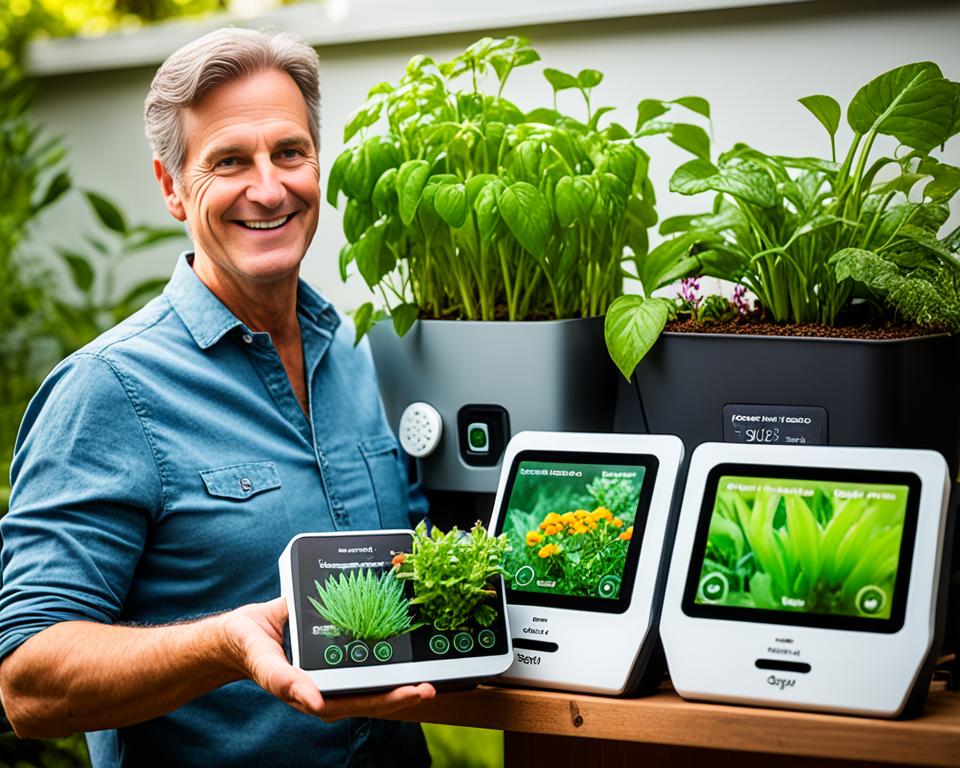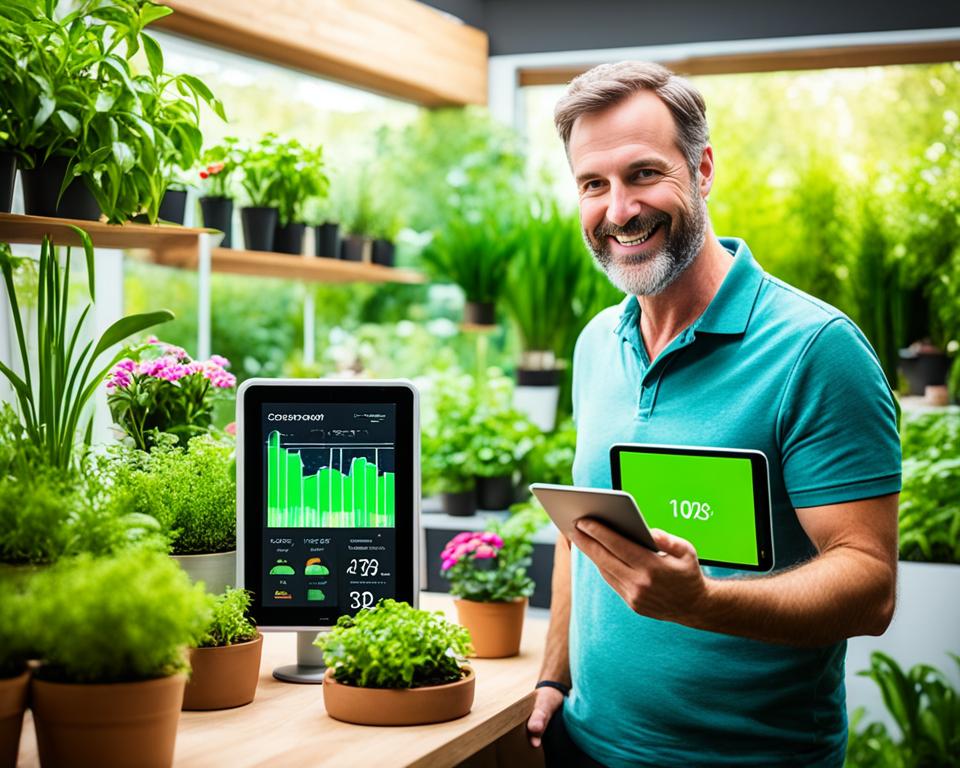Did you know that over 77% of American households engaged in gardening activities in 2022? Within this growing green movement, a trend that may surprise many is the burgeoning popularity of Smart Garden Monitors. These ingenious devices are turning thumbs greener across the nation, illustrating an evolving rapport between technology and nature. We’re stepping into an era where our indoor plant monitoring systems are as intelligent as our smartphones, and our smart plant care systems are doing more than just guiding us—they’re actively nurturing our gardens to perfection.
Imagine the convenience of receiving timely alerts to water your ferns or the luxury of knowing precisely when your tomatoes need that extra dose of potassium. The precise calibration provided by these monitors helps us cater to the unique requirements of every plant species in our living spaces. We’ll explore how these advanced systems are not merely gadgets, but essential partners in the quest to cultivate thriving, resilient plants. So, join us as we delve into the benefits and inner workings of these modern marvels—our flora has never been in more capable hands.
Why Smart Garden Monitors Are Revolutionizing Plant Care
As we embrace urban gardening and seek harmony with nature, automated garden sensors and smart agriculture technology have emerged as game-changers. The integration of IoT garden monitoring solutions into our botanical endeavors reflects a transformation in how we approach plant care. This shift is propelled by the ability of these devices to furnish us with comprehensive insights and control over our green spaces, enhancing the health and longevity of our plants.
Understanding Smart Agriculture Technology
The backbone of this revolution lies in the precision and adaptability that smart agriculture technology offers. It’s a toolkit that imbues traditional gardening with a heightened sense of intelligence and responsiveness. Equipped with sensors to monitor soil, light, and nutrients, these innovative devices empower us to understand the unique needs of each plant. We’re not only gardening; we’re also stewarding a micro-ecosystem with data-driven care.
The Rise of IoT in Plant Management
Iot, or the Internet of Things, extends its web to the realm of horticulture, ushering in an era of real-time garden oversight. Suddenly, we’re connected to our gardens like never before, with IoT garden monitoring solutions providing live updates and alerts that invite us to respond immediately to our plants’ demands. It’s a proactive, rather than reactive, approach that redefines plant management and care.
Comparing Traditional vs. Smart Plant Care Systems
When we compare the traditional, manual methods of gardening to the efficiencies brought about by smart systems, the differences are stark. These modern monitors dispense with guesswork and offer a level of detail that goes beyond the mere eye. Let’s consider the contrasts:
| Aspect | Traditional Methods | Smart Plant Care Systems |
|---|---|---|
| Monitoring | Periodic checks, prone to human error | Continuous, accurate data collection |
| Responsiveness | Delayed, based on visible signs | Instant alerts, foreseeing potential issues |
| Data Utilization | Limited, qualitative insights | Detailed, quantitative analytics |
| Care Precision | General care for overall garden health | Specific care for individual plants’ needs |
It’s evident from the table above that smart garden monitors are pioneering a new standard in horticulture, rendering them indispensable for the contemporary gardener. Join us as we further explore these innovations, ensuring our green spaces receive nothing short of the finest in plant care technology.
Choosing the Right Smart Garden Monitor for Your Needs

With the growing array of options in smart garden technology, it’s crucial for us to discern which wireless plant monitoring device or connected garden sensors best cater to our greenery’s demands. The selection process goes beyond a simple impulse buy—it’s about understanding the capacities and features that intertwine with our unique gardening aspirations. Let’s navigate together the aspects that will influence our choice and ultimately, the fulfillment of our plants’ potential.
When we begin to compare devices, we’re not only evaluating technology; we’re assessing our commitment to our gardens’ prosperity. A small herb garden on a windowsill has different needs than a sprawling backyard vegetable plot. Here’s how we can break down the decision-making process:
- Garden Size: Will the devices need to cover a large area, or will they be monitoring individual pots?
- Variety of Plants: Do we need sensors that can differentiate between the needs of various species?
- Connectivity: How do these devices integrate with our home network, and are they compatible with our existing smart home ecosystem?
Wireless plant monitoring devices with straightforward soil moisture or sunlight sensors might suffice for casual gardeners. In contrast, an enthusiast with an extensive collection of exotic plants could benefit from more intricate connected garden sensors that track environmental changes with precision.
Let’s put this into perspective with a helpful table that maps out key considerations and the respective features that we should look for:
| Consideration | Feature | Benefit |
|---|---|---|
| Size of Garden | Multi-sensor capability | Efficient monitoring of different garden zones |
| Types of Plants | Adjustable sensitivity | Personalized care for diverse flora needs |
| Smart Home Integration | Compatibility with smart systems | Seamless operation within smart home platforms |
| User Experience | Intuitive app interface | Convenient and simple to use for all gardeners |
We understand the impact of a meticulously chosen wireless plant monitoring device on our gardens’ health and our satisfaction as gardeners. Acknowledging our needs and how these connected garden sensors can meet them will lead us to a harmonious relationship with our tech-assisted green sanctuaries.
The Role of Smart Garden Monitors in Indoor Gardening
Indoor gardening is an art that balances beauty with practicality, especially when dealing with the limitations and challenges inherent to the indoors. It requires not only passion but also precision to ensure that our cherished plants thrive. This is where the integration of smart garden monitors becomes invaluable. These sophisticated tools are redefining our relationship with indoor gardening, by leveraging technology to refine the traditional indoor plant monitoring system.
Enhancing Your Indoor Plant Monitoring System
By incorporating smart garden monitors into our indoor ecosystems, we take a significant leap from the conventional ways of plant monitoring. These devices come equipped with sensors that facilitate a level of care once reserved for the most diligent gardeners. Whether it’s adjusting for the right light, maintaining ideal humidity levels, or ensuring that the soil conditions are just right, smart monitors can simulate the ideal growing conditions that every plant variety yearns for.
Integrating Automated Garden Sensors into Your Home
Our homes are our sanctuaries, and the plants we nurture within them are more than just decoration—they’re companions. Introducing automated garden sensors into our domestic spaces is not just about technological sophistication; it’s about creating a nurturing haven for our indoor greenery. These sensors offer a hands-free approach to garden management, perpetually adjusting to maintain environmental factors even when we’re caught up in the hustle and bustle of daily life. It’s a testament to how smart technology and nature can coexist harmoniously in our living spaces, ensuring the plants we love get exactly what they need, when they need it.

